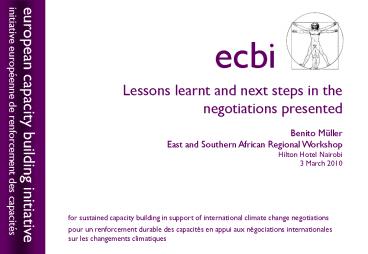Negotiation Indices - PowerPoint PPT Presentation
1 / 10
Title:
Negotiation Indices
Description:
The Issue of Distributive Justice and Thematic Balance Distributive Justice Traditional ODA neither involves ... Negotiation Indices Author: M ller Last modified by: – PowerPoint PPT presentation
Number of Views:119
Avg rating:3.0/5.0
Title: Negotiation Indices
1
ecbi
Lessons learnt and next steps in the negotiations
presented Benito Müller East and Southern
African Regional Workshop Hilton Hotel Nairobi
3 March 2010
european capacity building initiative initiative
européenne de renforcement des capacités
for sustained capacity building in support of
international climate change negotiations pour un
renforcement durable des capacités en appui aux
négociations internationales sur les changements
climatiques
2
The Issue of Distributive Justice and Thematic
Balance
- Distributive Justice
- Traditional ODA neither involves obligations to
pay, not entitlements to receive. Hence, strictly
speaking, there is no issue of contributing or
receiving a fair share - The nature of financial payments for climate
change activities, particularly in the case of
adaptation and response to climate impacts is one
of restitution. - Hence there are both obligations to pay and
entitlements to receive, which implies that
equity, in these sense of either shouldering a
fair share of the payment burden, or receiving a
fair share of the revenue is an issue. - At present, the focus really has only been of the
former (e.g. Mexican and Swiss proposals). Few
have raised the issue of how to distribute
climate finance equitably. - Thematic Balance
- Climate change finance involves a number of
different themes (mitigation, adaptation
,technology transfer, etc. ), and the issue of
thematic balance is whether each of these
themes receives an appropriate share of the
revenue.
3
Three Fundamental Dichotomies
Fragmented v. Consolidated Centralized v.
Decentralized Devolved v. Retained
(a) Retained, Fragmented, Decentralized (b)
Devolved, Consolidated, Decentralized (c)
Retained, Consolidated, Centralized
4
Centralized Decision Making The Problem of
Administrative Size
Multilateral Fund (0.19 people/m)
Global Fund (0.21 people/m)
Expected Size (0.2 people/m)
5
RFM Core Consolidation and Decentralization
through Devolution
UNFCCC Conference of Parties (COP)
External Audit
Operating Entity
Executive Board
Expert Advisory Panel(s) (as required)
Administrative Services
RFM Trustee
Thematic Assessment Units (one per disbursement
window)
Internal Audit
Secretariat Services
International Level
Domestic Level
Designated Funding Entities
Direct Access
Legend Governance Relation (under the authority
of) Contractual Relation (MOU or contract)
6
Funding versus Disbursement
- Disbursements to Designated (National) Funding
Entities - Funding is financing (incl. approval and
evaluation) of activities such as projects,
programmes) - Disbursements are dependent on the disbursement
criteria for each theme, as well as the thematic
allocations (both approved by the COP on
recommendation by the EB). They do NOT rely on
evaluations of projects, plans or strategies. - Disbursement Criteria
- Disbursement criteria will vary from theme to
theme. For example - Mitigation disbursements could be on a
performance basis, with an flat per country
component - x million y million for the MRV reduction in
the previous period - Adaptation disbursements should be carried out by
a very simple disbursement formula, e.g. a flat
per country component a component proportional
to the number of poor inhabitants.
7
RFM International Funding
- The bulk of the transactions in terms of size of
the RFM is (ultimately) meant to be carried out
through money-in-money-out disbursements to
designated (national) funding entities. - However, there will still be a need for
international funding in the more traditional
sense, such as currently developed under the
Adaptation Fund. - For one, not all funding purposes lend themselves
naturally to be devolved to the country level.
While mitigation and adaptation per se would seem
to be prime candidates for such a devolution,
funding decisions for certain types of capacity
building and technology transfer activities may
be better kept at the international level. - Even with respect to the other themes, there will
for some time to be the need to retain a more
traditional international funding capacity, for
it may take some time before all countries will
be able to participate in the devolved
disbursement regime.
8
The LCA Draft Decision
UNFCCC COP
Finance Board
Climate Fund/Facility
9
Coordination or Consolidation Potential for
Compromise?
UNFCCC COP
RFM Administration
Finance Board
International Level
Climate Fund/Facility
Operating Funding Entity 2 (Adaptation)
Operating Funding Entity I (Mitigation)
Administrative Services, incl. Thematic
Assessment Units
National Level
Designated Funding Entity
Legend Governance Relation (under the authority
of) Contractual Relation (MOU or contract)
Oversight and governance/contractual RFM
Operating Entity Disbursement/Certification
International funding/Coordination
10
- Thank you!































